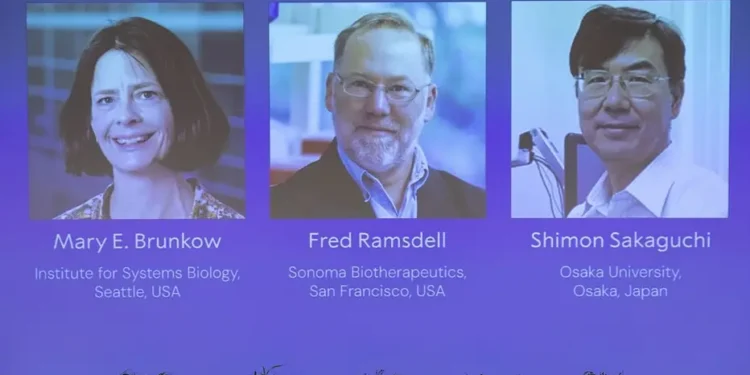Mary E. Brunkow, a Seattle-based senior program manager at the Institute for Systems Biology, won the Nobel Prize in Medicine Monday alongside Fred Ramsdell and Dr. Shimon Sakaguchi for discoveries concerning peripheral immune tolerance.
Brunkow, 64, shares the prize with Ramsdell, 64, a scientific adviser for Sonoma Biotherapeutics in San Francisco, and Sakaguchi, 74, a distinguished professor at Osaka University’s Immunology Frontier Research Center in Japan.
“Their discoveries have been decisive for our understanding of how the immune system functions and why we do not all develop serious autoimmune diseases,” said Olle Kämpe, chair of the Nobel Committee.
The Karolinska Institute in Stockholm announced the award Monday, marking the first of the 2025 Nobel Prize announcements. The trio will share prize money of 11 million Swedish kronor, nearly $1.2 million.
Brunkow learned of her prize from an Associated Press photographer who arrived at her Seattle home in the early morning hours. She had ignored an earlier call from the Nobel Committee. “My phone rang and I saw a number from Sweden and thought: ‘That’s just, that’s spam of some sort,'” Brunkow said.
“When I told Mary she won, she said, ‘Don’t be ridiculous,'” said her husband, Ross Colquhoun.
The prize-winning research began with Sakaguchi’s 1995 discovery of a previously unknown T cell subtype now called regulatory T cells or T-regs. In 2001, Brunkow and Ramsdell discovered a culprit mutation in the Foxp3 gene, which also plays a role in a rare human autoimmune disease.
Brunkow and Ramsdell were working together at a biotech company investigating why a particular mouse strain had an overactive immune system. They used new techniques to identify the mouse gene behind the problem and quickly realized it could significantly affect human health.
“From a DNA level, it was a really small alteration that caused this massive change to how the immune system works,” Brunkow told AP.
Two years later, Sakaguchi linked the discoveries showing that the Foxp3 gene controls T-reg development. These T-regs act as security guards finding and curbing other T cell forms that overreact.
The immune system employs many overlapping systems to detect and fight bacteria, viruses, and other intruders. Key immune warriors like T cells train to spot threats. If some go awry in ways that might trigger autoimmune diseases, they should be eliminated in the thymus through a process called central tolerance. The Nobel winners unraveled an additional way the body maintains system checks.
The work opened a new immunology field, said Karolinska Institute rheumatology professor Marie Wahren-Herlenius. Researchers worldwide now work to use regulatory T cells developing autoimmune disease and cancer treatments.
Dr. Jonathan Schneck, a Johns Hopkins University pathology professor studying T cells, said immunologists didn’t understand the complexity of how the body differentiates foreign cells from its own and tamps down overreactions until the trio’s research published.
The discoveries haven’t yet led to new therapies, Schneck cautioned. But “it’s incredibly important to emphasize, this work started back in 1995 and we’re reaping the benefits but yet have many more benefits we can reap” as scientists build on their work.
Thomas Perlmann, Nobel Committee secretary-general, reached only Sakaguchi by phone Monday morning. “I got hold of him at his lab and he sounded incredibly grateful, expressed that it was a fantastic honor. He was quite taken by the news,” Perlmann said, adding he left voicemails for Brunkow and Ramsdell.
At a news conference, Sakaguchi called his win “a happy surprise,” saying he expected to wait longer until the research makes more clinical science contributions. Initially, his research area wasn’t popular and he struggled for funding, but cooperation with interested scientists led to achievement.
“There are many illnesses that need further research and treatment, and I hope there will be further progress in those areas so that findings will lead to prevention of diseases. That’s what our research is for,” Sakaguchi said.
Japanese Prime Minister Shigeru Ishiba interrupted Sakaguchi’s news conference with a congratulatory call, asking about clinical application timeframes for cancer treatment. “Hopefully we can reach that stage in about 20 years, though I’m not sure if will still be around,” Sakaguchi replied. “But science will advance and by that time cancer will no longer be scary but treatable.”
The award ceremony will be December 10, the anniversary of Alfred Nobel’s death. Nobel was a wealthy Swedish industrialist and dynamite inventor who died in 1896 and founded the prizes.







